History of AEW: Project Cadillac II (Part One)
 21 February 1945. Bismarck Sea (CVE 95) is sunk by kamikaze attack off Iwo Jima. In the same action, USS Saratoga (CV-3) was removed from action for what would be the remainder of the war and USS Enterprise suffered significant damage.
21 February 1945. Bismarck Sea (CVE 95) is sunk by kamikaze attack off Iwo Jima. In the same action, USS Saratoga (CV-3) was removed from action for what would be the remainder of the war and USS Enterprise suffered significant damage.
April-May 1945. Kamikazes are extracting a heavy price during the invasion of Okinawa. On the 16th of April, a massed-wave of 350 kamikazes hit the fleet; 20 alone attacked the destroyer USS Laffey and the heavy carrier, Franklin was severely damaged — only by the heroic efforts of her crew was the Franklin able to remain afloat, but the ship would be out of action for a long time. On subsequent days Enterprise suffered more damage, along with Hancock, Bunker Hill, Intrepid and a number of picket destroyers. As the run-up to the invasion of the Japanese homelands approached, leaders in theater and back in Washington were growing increasingly concerned over the threat kamikazes were presenting and what it portended for DOWNFALL. On the West Coast, USS Ranger was preparing to embark an airwing with several innovations, including the first operational TBM-3Ws in order to provide an organic AEW capability.
As revolutionary as the TBM-3Ws were though, there were limitations to their capabilities. Chief amongst these was the fact that the -3W was not much more than an airborne radar antenna, relaying data back to the ship where targets were plotted and interceptors dispatched. Having that capability in an airborne platform would reduce time delays and reliance on what could be a problematic video link. In 1944, BuAer began examining candidates for this capability and narrowed the list down to three candidates — the B-24, C-54 and B-17. All were in production and available in sufficient numbers for use as a land-based platform.
Because the plan was to use the same configuration as the TBM-3W (to save development time), the B-24 was the first eliminated from consideration because of its high-mounted wing and low ground clearance. The C-54 was considered a strong possibility because of the space its fuselage offered as a cargo aircraft along with a faster cruise speed than the B-17, but with the projected area of operations being a combat zone, the battle proven B-17 was the platform of choice.
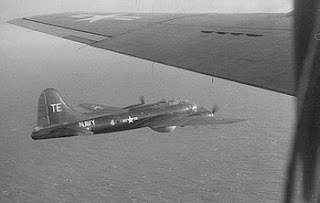
Cadillac II
With two distinct branches — Cadillac I for the carrier-based AEW and Cadillac II for the shore-based variant, the Navy pressed ahead with the procurement of PB-1s (Navy designation for the B-17). Beginning with twenty license-built Douglas B-17s (1), originally planned for the Army Air Force, the PB-1s were sent to the Naval Aircraft Modification Unit, located at Johnsville, PA (2). There the conversion to the AEW variant would take place. The modifications began in late 1945 with the first operations in February 1946 (3). PB-1Ws were configured to one of two versions — a CIC version and a reconnaissance version. Both versions had an AN/APS-20 radar mounted in the sealed off bomb bay with the TBM-3Ws dome. The CIC version added installation of a CIC aft of the bomb bay that had three ground-stabilized radar consoles with 12 –inch displays, a vertical plotting and other status boards and communications and radio/navigation equipment (VHF/HF/LF comms, IFF, DF equipment, LORAN). The reconnaissance version was long-range replica of the TBM-3W with just two radar consoles. The cockpit saw a reconfigured instrument panel that provided dual sets of flight instruments and improved lighting. Early PB-1s also retained much of their original armament, though the top and chin turrets were disabled or removed. Provisions were made for carrying two x 300-gal drop tanks for ferry flights. The early PB-1Ws were left in a natural finish as it was thought this would help their range without the added weight of paint. As the aircraft went back through re-work they would be painted in the now-familiar dark-blue paint scheme.
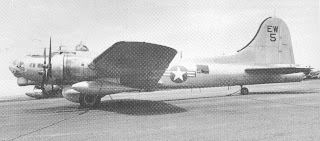 A few airframes were modified to move the radar antenna to the top of the fuselage to evaluate using the airframe to blank out large clutter discretes in the vicinity of the aircraft:
A few airframes were modified to move the radar antenna to the top of the fuselage to evaluate using the airframe to blank out large clutter discretes in the vicinity of the aircraft: 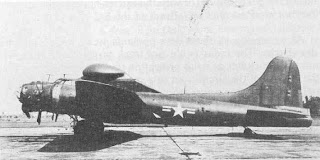 These clutter discretes were the result of the position of the radar antenna and large returns generated by either ground- or sea-return along the aircraft’s flight path. This is particularly important when adding moving target indicators (MTI). MTI or Airborne MTI (AMTI) cancels this clutter, enabling the detection of airborne moving targets. In the case of the Cadillac radar, this clutter was severe enough to obscure aircraft at ranges out to 30-50 nm. The Cadillac AMTI-system was described in a 1946 National Defense Research Committee technical paper as follows:
These clutter discretes were the result of the position of the radar antenna and large returns generated by either ground- or sea-return along the aircraft’s flight path. This is particularly important when adding moving target indicators (MTI). MTI or Airborne MTI (AMTI) cancels this clutter, enabling the detection of airborne moving targets. In the case of the Cadillac radar, this clutter was severe enough to obscure aircraft at ranges out to 30-50 nm. The Cadillac AMTI-system was described in a 1946 National Defense Research Committee technical paper as follows:
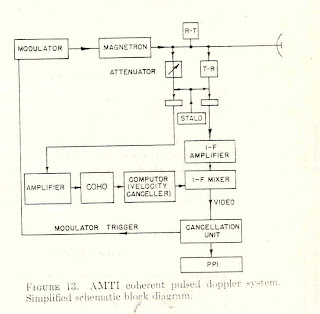
The Cadillac system was an S-band system that utilized a pulsed coherent Doppler principle for AMTI processing (ed: see diagram above). The transmitted r-f pulse from the magnetron beats with a stable local oscillator (STALO) and starts up the 30-mc coherent oscillator in a phase which depends upon the combination of the STALO and r-f phases. The returning echo beats with the STALO and produces an intermediate frequency (i-f) whose phase depends on the combination of the phases of STALO, r-f and phase due to the range of the target.
If the target remains at a fixed range, then the phase of the i-f bears a fixed relationship with respect to the COHO. When the i-f and the COHO are combined in the detector, the resulting video signal will be up or down, and its amplitude from pulse to pulse will be fixed. The phase, caused by moving targets will change from pulse to pulse, and the video will show amplitude modulation. For the airborne system the fixed targets are also moving and their motions can be cancelled out by introducing the proper phase shift in the starting phase of the COHO from pulse to pulse. This is accomplished in the computer box, where by an ingenuous system of high frequency carriers and single-sideband amplifiers and detectors, the COHO, at 30 mc, is mixed with an audio frequency fθ of from 0 to 3500 c to produce a new frequency equal to 30 mc ± fθ. A block diagram of the phase shifter portion of the computer box is provided below.
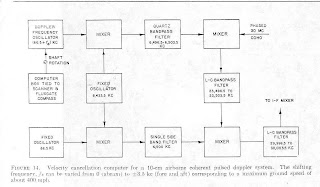 Altogether a fairly sophisticated system even by today’s standards. The same core principles carry over to such noteworthy AEW platforms as the E-3 AWACS and E-2C Hawkeye although the techniques are quite a bit more complex givent he robust environments they operate within.
Altogether a fairly sophisticated system even by today’s standards. The same core principles carry over to such noteworthy AEW platforms as the E-3 AWACS and E-2C Hawkeye although the techniques are quite a bit more complex givent he robust environments they operate within.
It was not enough, however, to merely develop the platform and hand it over to the fleet – training, tactics and procedures had to be developed and the system itself evaluated. In the post-war environment a fairly robust evaluation program was undertaken by the Navy’s OPTEVFOR (Operational Test and Evaluation Force) to determine the strengths and weaknesses of the system and what applications it might best be used for. The gist of that report forms the basis for Part Two of the Cadillac II series.
to be continued
 ______________________
______________________
End notes:
(1) In actuality, the PB-1 designation was probably in error. Although the B-17 was originally a Boeing designed and built product, other manufacturers were producing the bomber by this point in the war, most notably Douglas and Lockheed-Vega. The PB-1 designation had already been used for a Boeing built Naval Aircraft Factory flying boat, built in 1925. If properly designated, it should have been P4D-1W for the 4th Douglas design, first variant patrol aircraft accepted for Navy service, equipped for AEW. (B-17 In Blue, Thompson, p.8)
(2) The NAMU was a part of Mustin NAF, on the grounds of the Philadelphia Naval Station.
(3) Recall that planning at the time, exclusive of success of the atomic bomb, was for the invasion of the southern Japanese homeland to begin in November 45 and to be followed by Coronet (the main plain) sometime in the spring of ’46, by which point the first of the PB-1Ws would be deployed for operations.

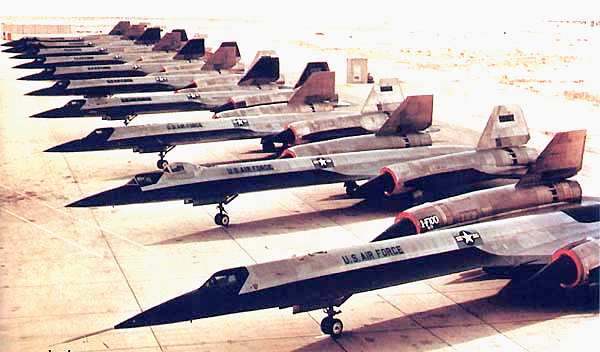
Gentlemen,
How did you come by my photograph???? One one in question is of PB-1W TE-4 which I took entoute to Japan/Korea in February 1953. You also do not have all your facts right about a PB-1W. First, there was only “one” PB-1W with the top mounted radome. Second, The CIC compartment was located in the Bomb Bay area above the Radom, not behind the Bomb Bay which was the radio compartment. I am also curious about the photo of TE-7 which was taken above NAS Barbers Point, Oahu, Hawaii
George E. Stewart USN
PB-1W Crew Chief 1951-1955
Airborne Early Warning Squadron One (VW-1)